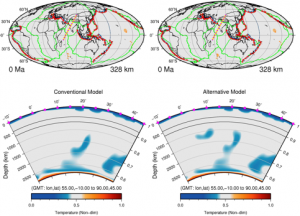 We present the input plate motion models and results from the study by Zahirovic et al. (2012) on the India-Eurasia collision using linked kinematic and geodynamic models.
We present the input plate motion models and results from the study by Zahirovic et al. (2012) on the India-Eurasia collision using linked kinematic and geodynamic models.
Two end-member scenarios of the India-Eurasia collision were tested. The conventional model invokes long-lived Andean-style subduction along southern Eurasia until continental collision between a maximum extent Greater India and Lhasa at ~60 Ma. The alternative scenario includes Tethyan intra-oceanic subduction, with back-arc opening along southern Eurasia from 120 to 50 Ma, and an initial collision between a smaller Greater India and the intra-oceanic subduction system at ~60 Ma. The back-arc is then subducted along an Andean-style margin until final continental collision at ~40 Ma.
Download the paper:
GCubed Paper
Download the data:
GPlates input files and CitcomS output temperature and lateral mantle flow velocities are provided below:
GPlates plate motion models* (~4 Mb)
Plate model animations (~110 Mb)
Comparison of vertical slices between conventional and alternative models through time (~ 10 Mb)
Regional time and depth-coded grids of temperature (~210 Mb)
Regional time and depth-coded horizontal mantle flow velocity (~40 Mb)
Vertical grids of CitcomS profile through time(~510 Mb)
If you use any of the resources, please cite the following publication Zahirovic, S., R. D. Müller, M. Seton, N. Flament, M. Gurnis, and J. Whittaker (2012), Insights on the kinematics of the India-Eurasia collision from global geodynamic models, Geochemistry Geophysics Geosystems, 13(Q04W11), doi:10.1029/2011gc003883.
*The GPlates input files are an earlier version of the final models used. The final models are in-house only because they contain not-yet-published deforming continental regions.
Feedback
We welcome any feedback. Send email.
![]()
